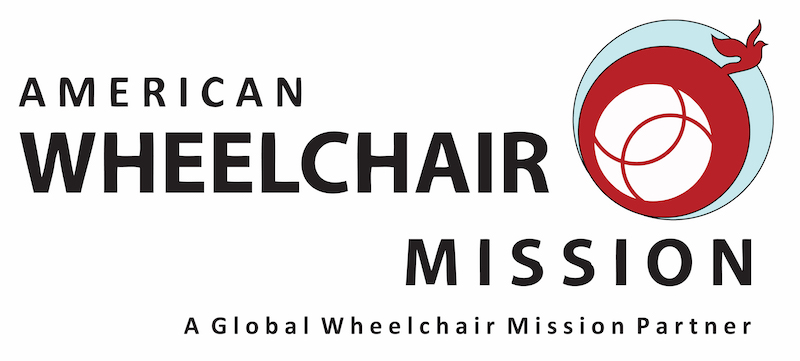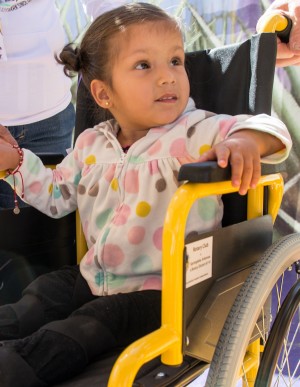At the very beginning of the wheelchair delivery mission in early 2000, the first images shared with the world were of children in far off countries receiving wheelchairs. These wheelchairs brought huge smiles to tiny faces and every member of their family. In the telling of our story and how we were improving lives with the tangible gift of a basic mobility wheelchair, we began striking a chord in the hearts and minds of young people throughout North America.
Before long we were receiving letters, photos and donations from elementary school classes that had made it their project to raise the money needed to sponsor a wheelchair, and then their great delight when they actually raised enough for 5 or 6. Middle schools, high schools and college students were becoming involved, and their creativity in coming up with ways to raise money for wheelchairs was astounding and often hilarious.
The Lisgar Interact Club, high school aged members of the Rotary Club of Ottawa, Canada, raised $350 with a “Kiss the Fish” fundraiser for wheelchairs. The concept was that various teachers from their high school had their names written on glass jars. Students would put money into the jar of the teacher that they wanted to see kiss the fish. The top three jars with the most money were put in order of first, second and third place. The first place winner would have to kiss the fish for 15 seconds, second place for 10 seconds and third place for five seconds. This was a televised festive event in Ottawa and no teachers or carp were injured in the raising of these funds.
But kids raising money to help the less fortunate is nothing new. From the earliest days of the “March of Dimes” campaign in 1938 when comedian Eddie Cantor said on national radio that Americans should send dimes directly to the White House to fight polio, children became very involved in collecting money to combat the epidemic. The “MDA Backyard Carnivals” started in the 1960’s by the Muscular Dystrophy Association involved children in a fun and creative way of helping kids with neuromuscular diseases.
In Selma, Alabama the fourth grade students at the Morgan Academy have raised enough money to sponsor 97 wheelchairs over the past three years. Teacher Amy Coffee says that the program started in conjunction with the Rotary Club of Selma, who has been very committed to the American Wheelchair Mission. Since March of 2001, Rotary Clubs, Districts and Rotarians worldwide have sponsored the delivery of hundreds of thousands of wheelchairs to over 100 countries, and have been instrumental in exposing their humanitarian efforts to affiliated youth groups, students and children in their local communities.
While visiting her parents on a break from Brigham Young University, Julie Anne Springman read an article in Diablo Magazine about the American Wheelchair Mission. She decided upon her return to school to try and raise the $21,000 necessary to sponsor a 280-wheelchair container to Lima, Peru where she knew of the great need for mobility from friends. Julie rallied family, friends, local businesses and anyone that would let her speak about her goal to raise a container of wheelchairs, and in five months succeeded in raising the funds necessary to change 280 lives in Peru. Julie and her mom traveled to Peru to help distribute the wheelchairs with the Rotary Club of Huacho, and declared it to be a life changing experience. The level of hospitality and gratitude of the people touched her the most, and now she is being asked to share her experience by teachers at BYU. Julie said, “This really put life into perspective for me, and I would love to do it all again.”
In Pretoria, South Africa 12-year-old Michelle Anita van der Schyff attended a wheelchair distribution sponsored by her grandparent’s Rotary Club. Michelle said, “I couldn’t believe how many people needed wheelchairs. There were young kids, teenagers and elders, and I felt very sorry for them. But as soon as they got a wheelchair, they were smiling and I even heard them laugh. That made me realize that I want to help the Rotarians have more functions like this so more people will be glad.”
Currently a freshman at the University of California at Berkeley, Lia Marshall was the spearhead of Rotary Interact District 5170’s wheelchair fund raising program last year that involved some 40 Interact clubs in the San Francisco Bay Area. Mobilizing high school students to participate in a series of events like a wheelchair marathon, a jog-a-than, a pie your teacher in the face competition, and Christmas caroling, the result was $47,250 raised to send 630 wheelchairs to Costa Rica, Guatemala and Panama. Lia joined by her parents Ed and Anita, members of the Rotary Club of Alameda, traveled to Costa Rica with other Interact members and Rotarians involved in the campaign to hand deliver wheelchairs that their hard work had provided.
Lia said of her experience in Costa Rica, “As I was setting up the wheelchairs, I saw a young wheelchair recipient for the first time. Her little hands clenched as though she fought to free herself of invisible chains. Looking at her, I smiled as a tear rolled down my cheek. I thought I had already overcome this when watching the videos of children crawling in the streets, but this was real. As I looked into the smiling faces of the recipients and their family members, I felt connected to them and saw that every bit of our hard work was now paying off. As so many people expressed their gratitude for the gift of mobility, I realized that whatever I pursue in my life, I will always bring my passion for helping others.”
As we step back and take a look at how fortunate we all are to be able to change thousands of lives on a monthly basis with the gift of a new wheelchair, it is clear that the motivating element in the hearts of people connected to our global mission is helping others. Could there possibly be a more important lesson that we would choose to teach our children? Love and concern for fellow human beings regardless of nationality, color or creed. Then we notice that it is the children and young adults who have taken this message to heart and embraced it as a part of who they are. Taking initiatives, creatively thinking, and becoming totally committed to achieving a goal that connects them with people in need of their help. It is gratifying to witness that not only are they learning from our examples, but there is much that we can learn from them.


